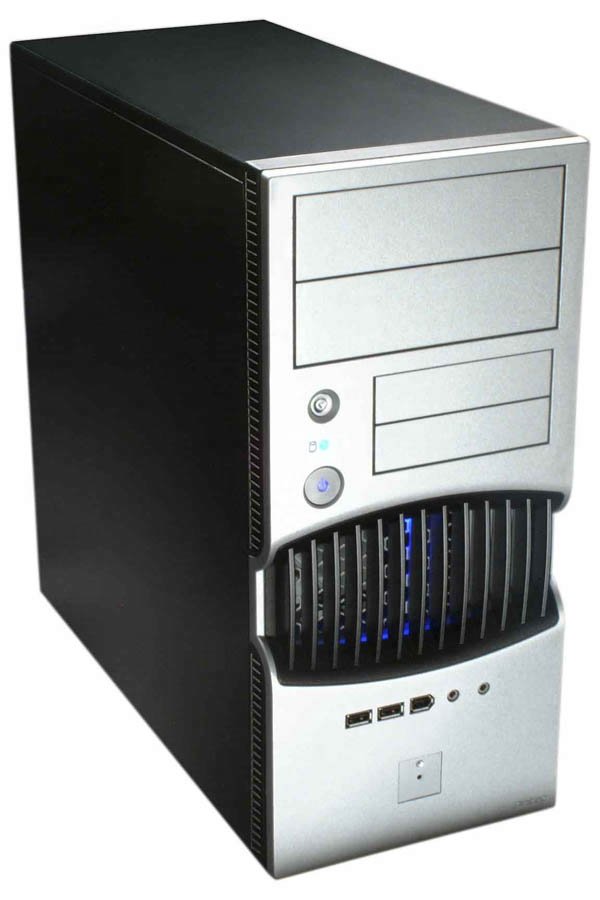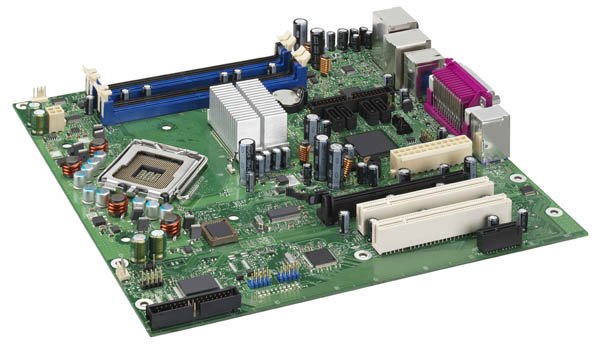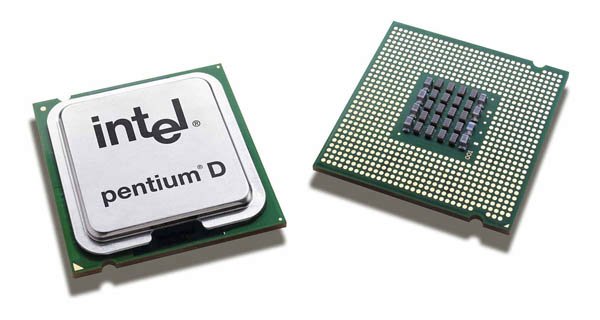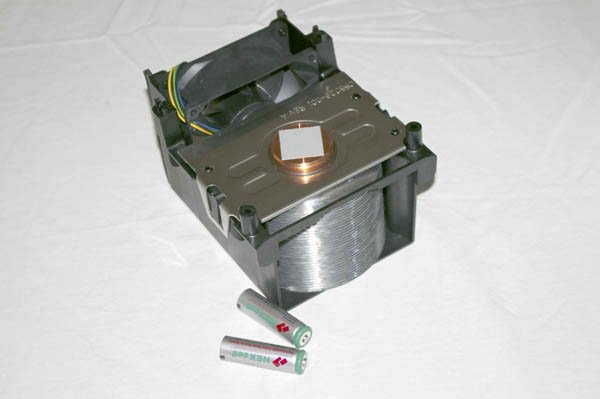Section 3.3. Component Considerations
3.3. Component ConsiderationsWith our design criteria in mind, we set out to choose the best components for the mainstream PC system. The following sections describe the components we chose, and why we chose them. Warning: Although we tested the configuration we used to build our own mainstream PC, we did not test permutations with the listed alternatives. Those alternatives are simply the components we would have chosen had our requirements been different. That said, we know of no reason the alternatives we list should not work perfectly. 3.3.1. Case and Power SupplyAntec BK640B microBTX Case (http://www.antec.com)Intel introduced the ATX form factor more than a decade ago, with the smaller Mini-ATX and microATX form factors introduced soon thereafter. Although Mini-ATX never caught on, ATX and microATX became immensely popular. Most commercial systems and nearly all home-built systems use ATX or microATX cases and motherboards to this day. But ATX was designed at a time when a typical processor or video adapter consumed only a few watts and used a passive heatsink. As the power consumption of processors and video adapters continued to grow by leaps and boundsreaching as much as 130W or morethe limitations of ATX became obvious. Getting rid of the heat became a major problem, despite such workarounds as the Intel TAC (Thermally Advantaged Chassis) initiative, which was a fancy name for a simple air duct between the processor and the side panel of the case. In addition to the CPU fan and power supply fan, ATX systems are usually equipped with at least one case fan to aid cooling. All of these fans inevitably add to the noise level of the system. Intel addressed the problem by introducing a new form factor called BTX (Balanced Technology eXtended). BTX cases feature a redesigned component layout, greatly improved air flow, and other measures designed to optimize cooling while minimizing the number, size, and speed of cooling fans needed. Despite the demonstrable superiority of BTX, manufacturers of motherboards and other components ignored BTX in droves. Intel had originally forecast that 40% of new systems would use BTX by the end of 2004. That turned out to be wildly optimistic, to put it kindly. With very few exceptions, system and component makers ignored BTX entirely, ridiculing BTX as a jerry-built fix for the notoriously high power consumption of Prescott-core Pentium 4 processors. ExtremeTech listed BTX in its Ten Failed Tech Trends for 2005 article. They weren't alone. By the end of 2005, most industry pundits had written off BTX as a dead technology.
But then something odd happened. Beginning in early 2006, BTX rose from the dead. Major OEMs, including Dell, HP, and Gateway, introduced new BTX models. Online vendors like NewEgg began offering BTX components, albeit in limited variety. Ironically, this revival began just as Intel began shipping the Core Solo and Core Duo processors, which consume much less power than earlier models and produce much less heat. If anything, these new, cooler-running processors should have been the final nail in the coffin of BTX. Instead, system makers apparently finally realized that if BTX could cool even hot processors with minimal noise, it could cool the newer low-current processors at extremely low noise levels. ExtremeTech reversed its opinion, saying in an April 2006 article, "If you're building an Intel system, it's worth considering moving to the BTX form factor." We agree. It's nice to see ExtremeTech belatedly endorse our conclusion. Although BTX appears to be gaining traction, its long-term viability is not yet assured. BTX cases and motherboards are now widely available, although the selection is quite limited. Despite these facts, we decided that the advantages of BTX were worth pursuing, so we decided to build our mainstream system around a BTX case and motherboard. We began by evaluating the BTX cases available at the time we built this system. We considered BTX cases from various manufacturers, including Antec, Casetek, CoolerMaster, InWin, Thermaltake, and others. We had several checklist items, the most important of which were:
Most of the cases we considered were too small, had too few drive bays, were too expensive, or otherwise failed to meet one or more of our requirements. The Antec BK640B, shown in Figure 3-1, met all of our requirements. Figure 3-1. Antec BK640B microBTX case (image courtesy of Antec, Inc.) The Antec BK640B belongs to Antec's mainstream line. It lacks some of the costly features included in premium Antec cases, but, like all Antec cases we have used, the BK640B is solidly built, has no sharp edges, and has excellent fit and finish. It is also an attractive case, and sells for only $75 or so, including a solid ATX12V v2.0 380W power supply. Finally, the Antec BK640B is an extremely quiet case. 3.3.2. MotherboardIntel D945GCZLR (http://www.intel.com)Intel motherboards set the standards by which we judge all other motherboards for construction quality, stability, and reliability. We chose the rock-solid Intel D945GCZLR, shown in Figure 3-2, which supports a socket 775 Intel Pentium 4, Pentium D, or Celeron D processor. Note the markedly different layout of a BTX motherboard, with the processor set at an angle near the front edge of the motherboard, the memory slots at the far left side, and the positions of the expansion slots and rear I/O panel reversed relative to ATX. Figure 3-2. Intel D945GCZ motherboard (image courtesy of Intel Corporation)
The Intel D945GCZLR provides integrated Intel GMA 950 video, which suffices for anyone other than serious gamers, and excellent integrated high-definition audio. The D945GCZLR has four DIMM slotswhich makes future memory upgrades easyand supports up to 4 GB of DDR2-400, -533, or -667 memory. It also provides a plethora of interfaces and ports, including two PCI slots, a PCI Express x16 video card slot, a PCI Express x1 general-purpose expansion slot, one dual parallel ATA-100 interface, four Serial ATA interfaces with RAID support, an FDD interface, PS/2 mouse and keyboard ports, serial and parallel ports for compatibility with legacy peripherals, a 10/100-BaseT Ethernet port, three FireWire ports, eight USB 2.0 ports, a digital optical out (S/PDIF) port, and a partridge in a pear tree.
3.3.3. ProcessorIntel Pentium D 940 (http://www.intel.com)A mainstream PC deserves a dual-core processor. Although a fast single-core processor can hold its own against a dual-core processor on a lightly loaded system, a dual-core processor really shines on a more heavily loaded system. As you add more background tasks and open more windows on a single-core system, the processor bogs down. With a dual-core processor, one core is always allocated to the foreground task, so the system appears just as responsive when it is heavily loaded as when it is running only one or two tasks. At the time we built this system, we had three dual-core technologies to choose from. We considered using the Intel Core Duo, which is essentially a desktop version of the Intel mobile processor, and was chosen by Apple as the basis of their Intel-based Mac systems. We rejected Core Duo for two reasons. First, although Core Duo processors were reasonably fast, they were also quite expensive compared to other dual-core processors with similar performance. Second, the selection of motherboards available for Core Duo was very limited, both in terms of the number of models available and the features supported by those motherboards. Core Duo was obviously an interim processor, introduced by Intel as a stopgap until they could ramp up production of their Conroe Core 2 desktop CPUs in late 2006 and into 2007. That left us with the AMD Athlon 64 X2 and the Intel Pentium D, both of which are excellent dual-core processors. The Athlon 64 X2 features an elegant design, low power consumption, and superior gaming performance. The Pentium D draws more power and is less suitable for gaming, but offers top-notch multimedia performance. Dollar-for-dollar, the Athlon 64 X2 and Pentium D are pretty evenly matched in performance at the high end. But at the time we built this system, the least expensive Athlon 64 X2 sold for about $300, a $75 premium over an Intel Pentium D model with similar overall performance. We chose to use the Intel Pentium D, shown in Figure 3-3, which in turn allowed us to build the BTX system we really wanted to build. Figure 3-3. Intel Pentium D (image courtesy of Intel Corporation)
3.3.4. CPU CoolerIntel Pentium D 940 retail-box coolerOrdinarily, the bundled CPU cooler supplied with a retail-boxed processor is quite a bargain. Bundled coolers are not as effective or as quiet as the best aftermarket CPU coolers, but they ordinarily add only $10 or $15 to the cost of the processor. At the time we built this system, that was not true of the bundled Pentium D BTX cooler, shown in Figure 3-4. (Two AA batteries are shown for scale.) Although the retail-boxed ATX version of the processor cost only a few dollars more than the bare OEM processor, the version with a BTX cooler sold for $30 to $40 more. (In addition to the bundled cooler, the retail-boxed version includes a much longer warranty on the processor.) Figure 3-4. Intel Pentium D retail box cooler, with square white thermal pad visible on base Intel supplied us with a retail-boxed BTX processor for this project, so we used the bundled CPU cooler. If we had bought the processor ourselves, we would probably have used an OEM processor with an aftermarket cooler. It's quite possible, though, that by the time you read this retail-boxed BTX processors will have achieved price parity with ATX models. Compare prices on a retail-boxed BTX processor versus the same processor in OEM form with a third-party cooler before you decide what to buy.
3.3.5. MemoryKingston 2GB PC2-5300 DDR2 memory kit (1 GB x 2) (http://www.kingston.com)Memory costs little enough that it is senseless to hamper a system by installing insufficient memory. We consider 1 GB appropriate for most single-core mainstream systems, although you may want more if you run Photoshop or other memory-intensive applications on your system. But using a dual-core processor is, for all intents and purposes, the same as using two processors. That means a dual-core system really needs twice as much memory as a single-core system, so we elected to install 2 GB of memory in our mainstream system.
The Intel D945GCZLR motherboard has four DIMM slots and a dual-channel memory controller that provides faster memory performance when DIMMs are installed in pairs. Installing a pair of 1 GB DIMMs, for a total of 2 GB, leaves two DIMM slots available for future expansion. If you need more memory later on, you can fill that second pair of DIMM slots with 1 GB modules, taking the system to 4 GB of total memory. That should suffice for the expected lifetime of the system. The Intel D945GCZLR supports DDR2-400 (PC2-3200), DDR2-533 (PC2-4200), and DDR2-667 (PC2-5300) memory. Although PC2-3200 modules would have been fast enough for our processor, we elected to install the faster PC2-5300 modules. The cost difference was small, and using the faster memory means we can later upgrade to a processor that uses a faster front-side bus without replacing the memory. 3.3.6. Video AdapterIntegrated Intel Graphics Media Accelerator (GMA) 950A mainstream PC needs excellent 2D video quality and, if it is to be used for casual gaming or running Windows Vista, support for DirectX 9 and reasonable 3D graphics performance. Intel GMA 950 video easily meets the first requirement, and even suffices for casual gaming and running Vista's Aero Glass effects, depending on your expectations. We had no intention of running Vista on this systemalthough we did install Vista to test compatibilitynor did we plan to use this system for anything more than casual gaming. Accordingly, we chose a motherboard that included integrated graphics, but with an available PCIe x16 slot in case we later decide to upgrade the graphics.
3.3.7. Video Capture AdapterHauppauge WinTV-PVR-150 (http://www.hauppauge.com)Although this system is not a full-blown media-center PC, we wanted it to have video capture capability, if only to serve as a backup to our primary media-center system when it was busy doing something else. We needed only a single-tuner analog capture card, so we chose the inexpensive and reliable Hauppauge WinTV-PVR-150 card. The PVR-150 provides hardware-accelerated MPEG compression, so the system can be used for other tasks while it is recording a TV program without any degradation of either task. The WinTV-Scheduler and WinTV-Editor utilities included with the card more than suffice for casual TV recording and editing. If you prefer to use a more featureful PVR application, the PVR-150 is supported by nearly every Windows and Linux PVR application available.
3.3.8. Sound AdapterIntegrated Intel High Definition AudioThe integrated Intel High Definition Audio is more than sufficient for anything other than serious gaming. The Intel D945GCZ model we used supports 7.1 audio, but other models support only 5.1 audio. We recommend using the integrated audio unless you require additional channels or you play games that benefit from hardware-accelerated audio.
3.3.9. Network AdapterIntegrated Intel Ethernet adapterIntel D945GCZ motherboards provide an embedded 10/100 or 10/100/1000BaseT network adapter, which you should use unless you have good reason for installing a standalone network adapter. 3.3.10. Hard Disk DriveSeagate Barracuda 7200.9 SATA (two) (http://www.seagate.com)A mainstream PC needs a mainstream hard drive, and you can't get much more mainstream than a Seagate Barracuda 7200.9 SATA drive. The Barracuda 7200.9 is inexpensive, fast, very quiet, and extremely reliable. It is available in capacities from 80 GB to 500 GB. We chose the 80 GB model because this system connects to our home network, which has more than 3,000 GB of network storage. There was no point to spending any more than necessary for local storage. If you need more local disk space, choose one of the larger models.
We decided our mainstream system deserved two hard drives, not to increase storage capacity but to reduce the risk of losing data to a hard drive failure. Seagate hard drives are extremely reliable, but as mechanical devices they are destined to fail, sooner or later. The best way to protect your data against a hard drive failure is to run two hard drives in a RAID 1. With RAID 1, all data is written to both hard drives. If one drive fails, data can be accessed from the second drive until you replace the failed drive and rebuild the RAID. The motherboard we chose includes built-in RAID 1 support, so the only additional cost for this protection is the $51 we paid for the second hard drive. That's cheap insurance by any reckoning.
3.3.11. Optical DriveBenQ DW1650 DVD writer (http://www.benq.us)DVD writers are now available for as little as $30, so it's pointless to choose a less capable optical drive. Although DVD writer manufacturers continue to make minor tweaks to their product lines, the technology is essentially mature. Nearly every model has similar features and writes the various types of discs at the same or similar speeds. More expensive models generally have larger buffers and provide a few bells and whistles that are of little practical importance. What counts is the durability of the drive and the quality of the discs it writes, and many current models, even some inexpensive ones, do well in both respects.
In the past, we used and recommended Plextor optical drives exclusively. Plextor still makes the best drives available, but the gap has narrowed. It's not that Plextor drives have declined in quality, but that inexpensive drives are now much better than they used to be. The BenQ DW1650 is among the best of the inexpensive drives, so we decided to use one for our mainstream system.
3.3.12. Floppy Disk DriveSince before the turn of the century, Microsoft and Intel have claimed that the humble floppy disk drive is a "legacy" device that should not be installed in modern systems. We took them at their word, more fool us. For five years, we've been building systems without floppy drives, and for five years we've frequently had cause to regret it. All too often, we ended up popping the cover on a PC to install a floppy disk drive because that was the easiest way to solve one problem or another. Intel at least provides motherboard BIOS updates that can be run from within Windows rather than requiring booting the system with a floppy disk to update the BIOS. That's fine for those who run Windows on an Intel system. Most of our systems run Linux, though, and the only way to update the Intel BIOS on a Linux system is to boot from a floppy disk. And many other motherboard manufacturers provide BIOS updates only as .bin files that must be loaded from a floppy. Microsoft is worse. When we install Windows, we frequently encounter the dreaded prompt to insert a floppy disk with a driver that Windows Setup requires for a RAID card or some other component. You'd think Microsoft would join the '90s and support loading drivers from a CD during Setup, but no. Windows Setup demands drivers on a floppy disk and will accept nothing else. We ran into the "can't get there from here" problem while testing the budget system, which had no floppy drive. Windows XP installed and ran perfectly on the budget system. After testing Windows, we blew away Windows and installed Linux. Then we realized that we needed to update the motherboard BIOS. Ooops. ASRock had a Windows BIOS updater, but we were no longer running Windows. ASRock also had a floppy-based BIOS updater, but we had no floppy drive. Arrrrrrghhh.
If we were smart, we'd ignore Microsoft and Intel and install a floppy disk drive on every system we build. That drive may be used only a few times over the life of the system, but at $6 or so an internal floppy disk drive is cheap insurance. Instead, while we had the system open, we temporarily installed an old FDD that was gathering dust on our workbench. We needed the FDD only long enough to install the Intel RAID drivers during Windows setup. After the system was up and running, we shut it down, disconnected the FDD, and reassembled the system. If you decide to install a floppy drive permanently in your system, don't worry about brand name. Buy whichever 3.5" FDD happens to be cheapest. It will probably run for literally only a few minutes over the life of the system, so durability is of little concern. 3.3.13. KeyboardLogitech Media Elite (http://www.logitech.com)Personal preference outweighs all else when choosing a keyboard. So many personal factors determine the usability of a keyboardstraight versus ergonomic, layout, key size, cup depth, angle, stroke length, corded versus cordless, and so onthat no one can choose the "best" keyboard for someone else. That said, we had to pick a "mainstream" keyboard for our mainstream PC, and our favorite mid-priced keyboard is the Logitech Media Elite, although we also like several of the other Logitech models. Microsoft also offers many excellent standard and ergonomic keyboard models, but we generally prefer the feel of Logitech models.
3.3.14. MouseLogitech LX7 cordless optical mouse (http://www.logitech.com)Personal preference is also the most important factor in choosing a mouse. Subtle differences in size, shape, button position, and so on can have a major effect on how comfortable a mouse is to use. What someone else loves, you may hate, and vice versa.
Years ago, Microsoft sent us prototype samples of their first "red light" optical mouse. We fell in love with optical mice, and used Microsoft optical mice exclusively for years. Several years ago, we tried a Logitech optical mouse and soon began replacing our Microsoft cordless mice with Logitech models. At the midrange and high-end, we actually prefer the feel of the Logitech mice. They feel more precise than the Microsoft models, and seem to fit our hands better. At the low end, Logitech and Microsoft optical mice seem comparable, but the Logitech models generally cost a bit less for models with features similar to competing Microsoft models.
3.3.15. SpeakersLogitech Z-2300 speaker system (http://www.logitech.com)A mainstream PC deserves a decent set of speakers, but we can realistically spend no more than $100 on speakers for a mainstream PC. There are scores of speaker systems available within that range, including sets with 6 or even 8 speakers. We decided it was better to spend our $100 on a good 2.1 systemtwo satellites and a subwooferrather than spending the same amount on a cheesy, tinny-sounding speaker system with a half dozen satellites. At 120W RMS for the subwoofer and 40W RMS for each satellite, the Z-2300 can rattle the walls when you're gaming, but at lower volume it's also fine for listening to anything from classical music to DVD soundtracks. The satellites do a good job on the midrange and highs, and the subwoofer provides excellent bass response for this price level. The THX-certified Z-2300 speakers are solidly built, and are attractive enough to use in your living room or den. The subwoofer includes an 8" long-throw woofer and the built-in amplifier. The satellites each use one 2.5" midrange/tweeter driver, and are brushed aluminum with removable grilles. The Z-2300 includes a wired remote with volume control, mute button, and headphone jack.
3.3.16. DisplayNEC MultiSync FE992 19" CRT (http://www.necmitsubishi.com) Samsung SyncMaster 997MB 19" CRT (http://www.samsung.com) ViewSonic G90FB 19" CRT (http://www.viewsonic.com)A mainstream PC should have a 19" display, and we allocated $200 to this component. That $200 buys us a top-notch 19" CRT monitor like the NEC MultiSync FE992, Samsung SyncMaster 997MB, or ViewSonic G90FB, or a mediocre 19" LCD display. In that price range, the CRT monitor wins hands down in every respect, including image quality and durability.
Table 3-1 summarizes our component choices for the mainstream PC system.
|
EAN: 2147483647
Pages: 84
- Key #3: Work Together for Maximum Gain
- When Companies Start Using Lean Six Sigma
- Making Improvements That Last: An Illustrated Guide to DMAIC and the Lean Six Sigma Toolkit
- The Experience of Making Improvements: What Its Like to Work on Lean Six Sigma Projects
- Six Things Managers Must Do: How to Support Lean Six Sigma